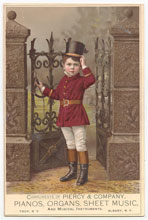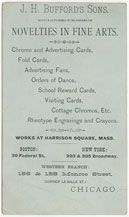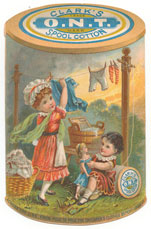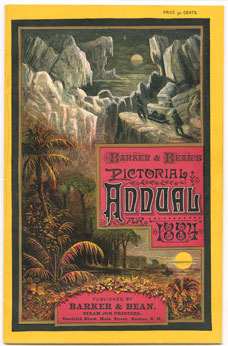The Art of American Advertising:
Advertising Products
“A pot of printer’s ink is better than the greatest gold mine.”
New York Times, October 14, 18945
Product advertisements in the early half of the nineteenth century generally appeared in the form of black-and-white broadsides (large single-sided sheets), simple business cards, or small newspaper notices. The growing volume of mass-produced and mass-distributed goods after the Civil War, however, led to the creation of diverse forms of advertising media. Advertising and printing enterprises worked in tandem to capture consumers’ attention and were an integral factor in extending products’ market reach nationwide.
Throughout the 1800s, black-and-white trade cards and business cards with fine detail were created through the process of engraving on wood, copper, or steel. Lithography, introduced to America in the 1820s, proved an ideal medium for commercial use, as it was less expensive and less time consuming to execute than engraving. Artists drew illustrations with a greasy pen, pencil, or crayon directly onto a flat, polished slab of limestone, rather than cutting into a woodblock or engraving, or etching a metal printing plate. Based on the principle of the repellent qualities of grease and water, lithography involves dampening the stone before applying oil-based ink that bonds with the greasy drawing on the stone, but does not stick to the wet, unmarked areas. Paper is then placed in contact with the stone to make a print.
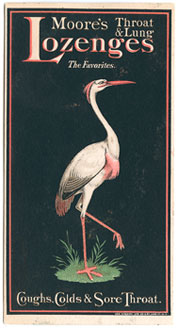
The lithographic process allowed advertising artists greater freedom of design than other printmaking methods. Print curators Sally Pierce and Catharina Slautterback explain, “Never before had printmaking offered the possibility for such spontaneity and directness of execution.”6 Chromolithographs—lithographs printed in multiple colors by means of a complex process of color separation that used one stone for each color—produced stunning, eye-catching advertisements in bold tones. “Even a cheap label has a depth and warmth of character if given the advantage of an extra printing,” Nathaniel Fowler’s advertising manual enthused.7 By the late 1800s, innovations in chromolithography, including the use of automated steam-powered rotary printing presses and curved zinc printing plates, expanded production to thousands of sheets a day and lowered costs further.
Lithography developed into a giant industry, from 60 companies in 1860 to 700 companies in 1890.8 The newly specialized field of advertising also grew exponentially as it became progressively complex. After the Civil War, for example, copy writing was done in house or externally by printers. By the turn of the century, J. Walter Thompson, E. C. Allen, N. W. Ayer & Son, and others eventually developed into full-service agencies taking on the responsibilities for copy, art, design, layout, and advertising campaigns previously done by companies themselves. “The expansion of the advertising industry in the last third of the nineteenth century was even more dramatic than that of the economy in general,” historian Robert Jay explains. “Between the 1870s and 1900, the volume of American advertising increased by more than tenfold.”9 The advertising budget for a company like Enoch Morgan’s Sons that manufactured the multi-purpose cleansing soap bar Sapolio jumped from $15,000 in 1871 to $400,000 in 1896. By 1905, the company was selling 16.5 million soap cakes a year—an average of one for every American family.
Advertising and printing industries enjoyed a symbiotic relationship in many respects. Rapidly developing advances in printing fed into expanding national markets that required advertising of brand name products. Additionally, the lucrative income generated from advertising clients helped printers invest in advancements in the industry’s technology. In How to Make Money in the Printing Business, published in 1900, Paul Nathan explained, “The intelligent job printer will never permit himself to forget that printing is allied to advertising, and that almost all of the printing he does depends in some way upon its success as an advertisement or as an advertising medium.”10
At the Centennial Exposition of 1876 in Philadelphia, exhibits featured the latest improvements in printing technologies and the products of commercial lithographers including the marvels of chromolithography. Referring to the United States as the “chromo-civilization,” the New York Times noted in 1888, “The rage for picturesque advertising which has marked the present popular renaissance in art has excited the keenest competitions in the production of beautiful designs and attractive novelties. The business in advertising cards has grown to enormous proportions, and the best talent in the country is employed in designing them.”11 While some critics decried that the overwhelming volume of mass-produced chromolithographs had created a democratic but cheapened form of art for the masses, advertisers well understood the power of the medium to capture consumers’ attention. As the Times observed, “The more beautiful and artistic a card or plaque is . . . the longer it will be kept in sight and talked about.”12
5“In Printer’s Ink the Secret,” New York Times, 14 October 1894, p. 21.
6 Sally Pierce and Catharina Slautterback, Boston Lithography 1825-1880, The Boston Athenaeum Collection. Boston: The Boston Athenaeum, 1991, p. 2.
7 Nathaniel Clark Fowler, Fowler’s Publicity: An Encyclopedia of Advertising and Printing. Boston: Publicity Publishing Company, 1900, pp. 654-655.
8 See Laird, p. 87.
9 Robert Jay, The Trade Card in Nineteenth-Century America. Columbia: University of Missouri Press, 1987, p. 34.
10 Paul Nathan, How to Make Money in the Printing Business. New York: Lotus Press, 1900, p. 36.
11New York Times, “High Art on Cardboard,” Dec. 3, 1882, p. 4.
12 New York Times Dec. 3, 1882, p. 4.


